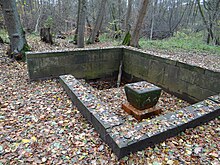Verden fountain
The Verdener Brunnen is a spring in the Lower Saxony district town of Verden . It is located in the northeast of the urban area in an extensive wooded area in the valley of the Halsebach, not far from the Verden Dunes nature reserve .
history
First developments
The spring was first mentioned in a document in 1670. According to legend, in 1744 a man suffering from stomach cramps quenched his thirst on the way home from the trickle that was gushing out of a sand hill. The more he drank, the better he felt and his suffering disappeared. This incident put the source in the interest of doctors.
Verden as a health resort
In 1768, the Royal Great Britain Chamber of the Electorate of Braunschweig-Lüneburg, based in Hanover , was told about the supposed healing properties of the water. In later years Johann Friedrich Westrumb carried out detailed chemical analyzes on site and came to the conclusion that it was a "weakly earthy-saline iron water" with a temperature of 4.5 degrees Réaumur (≙ 5.6 degrees Celsius ) show. He also stated the composition of the water, referring to 16 ounces (≙ 453.59 grams). This investigation produced the following results:
| Designation 1845 | Today's name | Molecular formula | Share in grams |
| Sodium chloride | Sodium chloride | NaCl | 0.100 |
| Calcium chloride | Calcium chloride | CaCl 2 | 0.175 |
| Soda sulfuric acid | Sodium sulfate | Na 2 SO 4 | 0.325 |
| Sulfuric acid talc earth | Magnesium sulfate | MgSO 4 | 0.175 |
| Carbonic lime earth | Calcium carbonate | CaCO 3 | 0.850 |
| Carbonic iron oxide | Iron (II) carbonate | FeCO 3 | 0.100 |
| Silica | Silicon dioxide | SiO 2 | 0.037 |
| Extractivstoff | organic distillation residue | - | 0.050 |
| Total solid components | 1.637 | ||
| Carbonic acid gas | carbon dioxide | CO 2 | 4.0 cm³ |
The physician Karl Christian Matthaei pointed out that mineral waters of this composition would have a soothing effect on gout , rheumatism , sciatic pain and chest discomfort. The Verden Hofmedicus Gerhard Matthäus Friedrich Brawe had the spring bordered with ashlar stones and in 1784 the first accommodation was built. In the first season already, around 650 spa guests were recorded. Over the years, several bathing houses and social houses as well as changing avenues and other accommodations were built on the site . Theater guest performances and dance evenings were organized on their own stages. The bathing activity increased steadily. In addition, a licensed casino soon opened , which was particularly popular among the officers of the nearby garrison barracks. From 1801 Matthaei worked as a balneologist at the Verden spring . The fountain flourished in the 1820s and 1830s when the bed capacity rose to around 100. Advertisements placed by the city of Verden in the Hanoverian magazine now officially advertised the source, which was dubbed “Gesundbrunnen” with public appeal, and the medical faculty of the Georg August University of Göttingen and doctors from all over the Kingdom of Hanover praised the healing power of water. The guests included well-known personalities from all regions of the German Confederation - including numerous commercial and privy councilors , but also the offspring of Bremen merchant families. Verden was about to develop into a fashionable spa .
Decline
It is assumed that many soldiers got into debt gambling or that too many duels were fought in the forest . What is certain is that officers were forbidden to stay in the Gesundbrunnen facilities from 1837 - this led to the casino being closed in the same year. The spa lost its entertainment value. In 1847 or 1850 the property had to be sold and the buildings were demolished by 1852 at the latest. Only one restaurant remained, the owner of which changed more than a dozen times by 1926. Then it was converted into the “ Schullandheim Verdener Brunnen”, which still exists today, by a parents 'and teachers' association .
In the 1920s, a Bremen company installed a bottling plant . More than 25,000 bottles of the mineral water were filled every day and shipped all over the world - including to Norddeutscher Lloyd , which took them on board its emigration ships to the United States, for example . As a result of the lowering of the groundwater, which presumably resulted from the pumping out of the Geest water by the city of Bremen, the well has mostly dried up nowadays. In addition, the water is no longer drinkable. A memorial stone commemorates the merits of Brawe and bears the inscription:
In
memory
of
Blessed Hofmed.
Dedicated to
Brawe
Individual evidence
- ↑ a b c Information about the Verdener Brunnen on the website of the Verdener Brunnen school camp. Retrieved from schullandheim-verdener-brunnen.de on November 8, 2015. As of July 31, 2017: No longer available.
- ↑ DWH Busch , et al. (Ed.): Encyclopedic Dictionary of Medicinal Sciences. 34th volume, Veit & Company, Berlin 1845, p. 328.
- ↑ DWH Busch, et al. (Ed.): Encyclopedic Dictionary of Medicinal Sciences. 34th Volume, Veit & Company, Berlin 1845, pp. 328-329.
- ↑ DWH Busch, et al. (Ed.): Encyclopedic Dictionary of Medicinal Sciences. Volume 34, Veit & Company, Berlin 1845, p. 329.
- ↑ B. Emigholz, G. Müller: Verden in the Biedermeier period. ( Memento from July 7th, 2012 in the Internet Archive ) 2008 published on domfestspiele-verden.de (Verden Cathedral Festival).
- ↑ B. Emigholz: The Verden "Gesundbrunnen" . In: Verden - anecdotes, legends, stories. Leaflet of the Stade Regional Association in the series: Paths into the cultural landscape between the Elbe and Weser. 42nd sheet. Retrieved from Landschaftsverband-stade.de on July 31, 2017.
Web links
Coordinates: 52 ° 56 ′ 34 ″ N , 9 ° 15 ′ 12 ″ E


